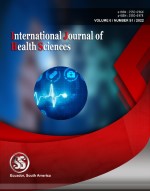Correlation between periodontal pocket depth and red complex bacteria among tobacco user
Keywords:
periodontitis, BANA test, tobacco user, probing depthAbstract
Aims- The present study is to evaluate the presence of red complex microorganism and relation with the prevalence of anaerobic bacteria and corelation with pocket depth in Periodontitis among tobacco user. Materials and Methods- The BANA (N-benzoyl-DL-arginine-naphthylamide) test was used to analyze subgingival microbiota. 400 subject age between 20-55 enrolled in this study, subject divided into three groups Tobacco Chewers, Tobacco Smokers, Both chewers and smokers and Non tobacco user. Result – The present study compared the subject with BANA test and pocket depth, the study shows tobacco smokers had deep pocket in comparison to other subject, which concluded that tobacco smokers show greater destruction of periodontium. Conclusion- Tobacco is harmful substance either it is used in any form (Chewing and Smoking), but study clearly indicate tobacco smoking are responsible for more destruction of Periodontium. The tobacco cessation programme should be implemented to prevent periodontitis and smoking prevention should be done by health education.
Downloads
References
Socransky SS, Haffajee AD., Cugini , M.A., Smith, C.& Kent, R.L. Jr.(1998). Microbial complexes in subgingival plaque. Journal of Clinical Microbiology, Vol.25 (No.2):134-144
Bollen C.M.L., Vandekerckhove B.N.A., Papaioannon W., Vaneldere J.,Quirynen M.(1996). Full–versus partial mouth disinfection in treatment of periodontal infections. A pilot study, long term microbiological observation. J. Clin. Periodontal Vol. 23:960-970.
Samaranayake L.(2006). Essential Microbiology for Dentistry, Churchill Livingstone Company, London: 275.
MooreW.E.C., Moore L.V.H (1994) The bacteria of periodontal disease. Periodontology 2000 Vol. 5: 66-77.
Bergstrom ,J.(1989) Cigarette smoking as risk factor in chronic periodontal disease. Community Dentistry and Oral Epidemiology, 17, 245-247.
Bergstrom, J., Eliasson, S. and Dock, J. (2000) Exposure to tobacco smoking and periodontal health. Journal of Clinical periodontology,27,61-68.
Grossi SG, Zambon JJ, Hov AW, Koch G, Dunford RG, Machtei EE et al. Assessment of risk for periodontal disease. Ris indicators for attachment loss. J Perio 1994; 65:260-267.
Haffajee AD, Socransky SS Relationship of cigarette smoking to attachment level profiles. J Clin perio 2001 28. 283-295
Loesche WJ: The identification of bacteria associated with periodontal disease and dental caries by enzymatic methods. Oral Microbial Immunol 1 : 1-6 1986.
Loesche WJ, Syed SA, Schmidt E, Morrison EC: Bacterial profiles of subgingival plaques in periodontitis. J Periodontal 56: 447-456, 1985.
Loesche WJ, Lopatin DE, Giordano J, Alcoforado G, Hujoel P. Comparision of the benzoyl-DL-arginine-naphthylamide (BANA) test, DNA probes, and immunological reagents for ability to detect anaerobic periodontal infections due to Porphyromonas gingivalis, Treponema denticola and Bacteroides forsythus. J.ClinMicrobiol. 1992 Feb; 30 (2): 427-33
Bretz WA, Eklund SA, Radicchi R, Schork MA, Schork N, Scottenfeld D, et al. The use of a rapid enzymatic assay in the field for the detection of infections associated with adult periodontitis. J public Health Dent. 1993 Dec; 53(4): 235-40
Takaishi Y, Morri H. Miki T. The benzoyl – DL arginine-naphthylamide (BANA) test and polymerase chain reaction measurement of pathogenic bacteria can assess the severity of periodontal disease. Int J Tissue React. 2003;25(1) :19-24.
C. Kazor, G. W. Taylor, and W. J. Loesche, “The prevalence of BANA-hydrolyzing periodontopathic bacteria in smokers,” Journal of Clinical Periodontology, vol. 26, no. 12, pp. 814–821, 1999.
Loesche WJ, Bretz WA, Kerschensteiner D, Stoll J, Socransky SS, Hujoel P, et al. Development of a diagnostic test for anaerobic periodontal infections based on plaque hydrolysis of benzoyl‑DL‑arginine‑naphthylamide. J Clin Microbiol1990;28:1551‑9.
Kamma JJ, NakouM, Baehni PC. Clinical and microbiological characteristics of smokers with early onset periodontitis. J Perio Res 1999; 34: 25 – 33.
Preber H, Bergstrom J, Linder LE: Occurrence of periopathogens in smoker and non-smoker patients. J Clin Periodontol 1992, 19(9 Pt1):667-671.
Hamdoon SM, Abdul Rahman Gh Y. Prevalence of Anaerobic Bacteria in Periodontitis in Relation to Pocket Depth Al- Rafidain Dent J. 2014; 14(2):320-328
Michiya Kubota1,2, Mariko Tanno-Nakanishi2, Satoru Yamada2, Effect of smoking on subgingival microflora of patients with periodontitis in Japan, BMC Oral Health 2011, 11:1.
Anil S, Hari S, Vijaykumar T. “Periodontal conditions of a selected population in Trivandrum district, Kerala, India”. Community dental oral epidemiology,1990; 18:325.
Published
How to Cite
Issue
Section
Copyright (c) 2022 International journal of health sciences

This work is licensed under a Creative Commons Attribution-NonCommercial-NoDerivatives 4.0 International License.
Articles published in the International Journal of Health Sciences (IJHS) are available under Creative Commons Attribution Non-Commercial No Derivatives Licence (CC BY-NC-ND 4.0). Authors retain copyright in their work and grant IJHS right of first publication under CC BY-NC-ND 4.0. Users have the right to read, download, copy, distribute, print, search, or link to the full texts of articles in this journal, and to use them for any other lawful purpose.
Articles published in IJHS can be copied, communicated and shared in their published form for non-commercial purposes provided full attribution is given to the author and the journal. Authors are able to enter into separate, additional contractual arrangements for the non-exclusive distribution of the journal's published version of the work (e.g., post it to an institutional repository or publish it in a book), with an acknowledgment of its initial publication in this journal.
This copyright notice applies to articles published in IJHS volumes 4 onwards. Please read about the copyright notices for previous volumes under Journal History.
















